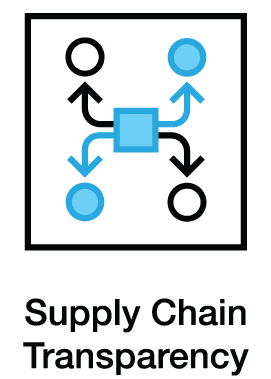Safer products through supply chain transparency

The second pillar of leadership: supply chain transparency
You can’t act on what you don’t know. And if you can’t take informed action, you can’t innovate in smart and sustainable ways. A key step toward achieving industry leadership on chemicals is to gain a full understanding of the chemical supply chain.
The second pillar, Supply Chain Transparency, informs a company’s decisions to effectively mitigate risk of current or pending chemical regulations and to efficiently allocate resources towards product innovation (see here). It also improves the data-set for product life cycle assessments, thereby yielding more firm-specific results. Above all, Supply Chain Transparency helps a company define and understand its starting point and its goals.
What does Supply Chain Transparency mean explicitly? EDF defines true transparency leadership as knowing the What, How Much, Why, and Who of the chemicals in one’s products.
What are the chemical ingredients?
Companies should strive for full transparency at the product level. This means knowing all the intentionally added chemicals, including those in chemical mixtures like fragrances, as well as known contaminants that occur in the making of the product.
As shown in our recent case study series, Seventh Generation moved to a different surfactant in its cleaning products to prevent contamination from 1,4 dioxane, a common residual contaminant in surfactant chemistries, recognized as a probable human carcinogen.
Achieving full transparency of the product prepares a company to respond to the changing regulatory landscape as well as shifting consumer demands. Consider, for example, that many jurisdictions have begun restricting or banning the use of certain types of phthalates commonly used in fragrance mixtures. It makes good business sense to have a full picture of product composition.
Obtaining generic chemical names is a start to knowing what’s in products, but the unique numerical identifier given to each chemical substance – the CAS number, or CASRN – pinpoints exact chemical identity and helps avoid confusion when some chemicals are referred to by multiple generic names. The “What” is the linchpin of leadership on Supply Chain Transparency.


How much is used?
It is critical to know the concentration of chemicals in a product to understand potential exposure. Per-product data better informs the potential risk from the use of one product. Concentration information at the product category and portfolio level aid in assessing aggregate exposure, the risk of exposure to a single chemical via all possible exposure routes and sources.
When dealing with How Much, EDF recommends that companies avoid concentration thresholds, or de minimis levels, that allow small amounts of purposefully added chemicals to go undisclosed. If a chemical is part of a product formula, it needs to be known.
Why is an ingredient used?
Understanding why a chemical is used in a product is about knowing its functional value. A chemical may be added as a preservative to prevent microbial growth, as a fragrance for scent, as a dye to impart color, and so on.
Knowing this information also helps to identify those areas, such as product preservation, where diversity of safer ingredient options may be lacking. This in turn can spur research and development of new alternatives that can meet the functional requirements with reduced human or environmental health impacts.
A company should gather functional data on all ingredients present in the final product.


Who makes the ingredients?
While a company’s direct suppliers, or Tier One suppliers, provide the first level of transparency into a product, they may not know the full formulation of a particular ingredient, such as a preservative or fragrance mixture.
In addition, a product may contain chemicals of concern that occur as contaminants, such as 1,4 dioxane, mentioned above.
To be fully knowledgeable, a company often needs to go beyond its immediate suppliers to secondary and tertiary sources, sometimes even to raw material suppliers. Building relationships with suppliers can improve ingredient transparency along the supply chain and facilitate innovative changes to formulations.
Overcoming hurdles on the path to leadership
Data management
Ingredient data management can be a laborious task, as companies often maintain complex product portfolios and large supply chains. An effective management process captures, stores, updates, verifies, and analyzes ingredient information. Paper-based data management continues to be a common initial step, particularly when financial resources are low or transparency initiatives are just getting off the ground, but it can be slow, tedious, and susceptible to human error. Fortunately, there are a number of software-based data entry and analysis systems available for managing ingredient data. Existing systems come in various forms and levels of complexity. When making data management decisions, a company needs to be diligent in mapping its requirements against the available systems. If a suite of internal and/or external management tools will be used, care should be taken to boost interoperability and connectivity. There are available systems that can help streamline data management processes, from those that inventory products and check regulatory compliance (e.g. WercSMART, SAP, IMDS, ToxNot) to those that also aid in toxicity analysis (e.g. SciVera, Material IQ).
Trust
Companies want to protect their intellectual property (IP). In some sectors, chemical make-up can be a company’s primary IP. So, naturally, ingredient transparency requests can cause trepidation. When seeking to lead on Supply Chain Transparency, a retailer or a brand must navigate how to gain access to the information it needs to understand and mitigate its business risks while assuring suppliers that legitimate IP is protected. Third-party software-based data management systems featuring data security protocols can be useful tools in mitigating trust issues.
Participation along the supply chain
Getting timely participation from the full supply chain can be challenging, particularly the further upstream a company needs to go to collect the necessary data. It can often take time and persistence. When a company is not a large purchaser, convincing suppliers to divulge ingredient details can be tough, especially if the request is optional. Suppliers can also be overwhelmed by separate requests from different companies that ask for data in slightly different ways. The good news is that as more and more companies are seeing the business value in transparency, supplier requests for ingredient disclosure are becoming a common business practice. As more suppliers face multiple requests for information, a greater emphasis is being placed on creating data uniformity that can benefit the entire supply chain (e.g. IPC-1752A, HPD, NSF/GCI/ANCI/355).

The bottom line
At first blush, leadership on Supply Chain Transparency might seem daunting. But with a growing list of available resources, more companies can join the ranks of Method, Apple, Ford, and Herman Miller who have paved the way.
Go to: The third pillar of leadership: informing consumers
Safer products: pillars of leadership
Safer personal care products for women of color
Handbook
5 Pillars of Leadership for Safer Chemicals
Guide
Safer products through institutional commitments
Guide
Safer products through supply chain transparency
Guide
Safer products through informing consumers
Guide
Safer products through better design
Guide
Safer products through public commitment
Guide